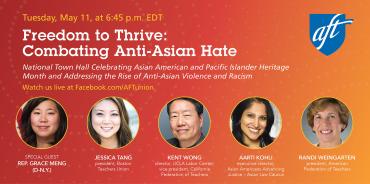It’s been a tumultuous year for members of the Asian American and Pacific Islander community, who have endured not just the racial epithets and bullying they’ve experienced historically but a marked increase in racist incidents. The rise—due to a perceived connection to COVID-19 and a Trump-influenced appetite for white supremacy—was amplified by the Atlanta murders of six AAPI women. At the AFT’s virtual town hall on May 11, a panel of AAPI leaders shared experiences and explored their vision for a better future.
“This year, Asian American and Pacific Islander Heritage Month takes on a more important meaning because of the hate crimes that we have confronted,” said AFT President Randi Weingarten, who moderated a discussion that included Jessica Tang, president of the Boston Teachers Union; Kent Wong, director of the UCLA Labor Center and a vice president of the California Federation of Teachers;
Rep. Grace Meng (D-N.Y.); and Aarti Kohli, executive director of the Asian Americans Advancing Justice – Asian Law Caucus. Panelists outlined the facts on anti-AAPI racism, described its deep history in the United States and considered solutions like the COVID-19 Hate Crimes Act that passed last month in the Senate, bystander intervention trainings, ethnic studies and the inclusion of Asian American history in school curriculum.
“The AAPI community is one of the fastest-growing racial groups in the country,” said Weingarten. “It’s growing four times faster than the total U.S. population, and is expected to double by 2060. It is a mosaic of rich cultural and ethnic diversity that represents over 100 languages and 50 ethnic groups. The history of Asian Americans in the United States is an integral part of American history.”
Yet this community has been facing an unprecedented wave of attacks, said Wong. He called it “deeply hurtful and disturbing” to see that elders are particular targets in a rash of violent incidents involving older Asian Americans and Pacific Islanders being pushed down and robbed in the street, stabbed, shot and otherwise assaulted.
Wong said history is an essential part of understanding this racism: “We have to confront the long history of anti-Asian prejudice and violence dating back well over a century,” including anti-Asian immigration policies that lasted for more than 60 years. Among the most significant were the Chinese Exclusion Act of 1882 and the Japanese internment camps of World War II.
Education is a key to turning the tide. “We all have a responsibility—as educators, school support staff, healthcare professionals, public employees and members of a broader community—to learn about our country’s shared history,” said Weingarten, who pointed to the AFT’s Stop Asian Hate webpage for resources including mental health supports, classroom lessons and tips on how to de-escalate violent encounters. The Asian Pacific American Labor Alliance’s Labor Toolkit on Anti-Asian Racism is another rich resource.
The Boston Teachers Union successfully advocated for the first ethnic studies coordinator in its district, said Tang, who linked knowledge of Asian American history and culture as key to fighting racism. She also suggests pressing for policies that support students and educators of color, noting that just 2 percent of the teaching workforce is made up of Asian Americans and Pacific Islanders. Interpretation and linguistic support for families is key as well—with so many different languages, many are “completely left out or neglected,” she said.
At the federal level, Meng was gratified to watch the COVID-19 Hate Crimes Act pass the Senate 94 to 1—a resounding bipartisan victory. The legislation makes data collection easier, with access to multiple languages and resources in the communities that need them; it should ultimately help local law enforcement more effectively investigate hate crimes.
Racism doesn’t always rise to the level of crime, though, said Kohli. “It’s stuff like racial epithets. Being refused service in a business. [Someone saying] ‘You can’t get in my Uber.’ You can’t necessarily legislate an answer to that level of racism.” The Asian Law Caucus is looking at other channels toward change, including bystander intervention training and community ambassadors who can walk with elders to keep them safe on the streets—since many of them are afraid to call the police. State and federal funding could help launch those efforts.
Schools play an important role as well, added Kohli. “Bullying of Asian American kids in schools is rampant,” she said. “I have yet to meet someone of my generation who didn’t deal with it.” Restorative practices can address some of this, and “teachers can play an important role in making sure we are seen and that we learn how, together with other communities of color, we can build together this vision of the America that we want to see.”
“Asian American and Pacific Islander Heritage Month is a time to stand together and to see the incredible beauty and diversity that exists in the AAPI community,” said Wong. “I also think it’s time to get organized.” From teacher strikes to voting rights work to the courageous immigrant youth fighting for immigration reform, he said, “Organizing changes lives.”
Watch the discussion here.
Download the Asian Pacific American Labor Alliance’s toolkit here.
Visit the AFT’s Stop Asian Hate webpage at www.aft.org/stopasianhate.
[Virginia Myers]

